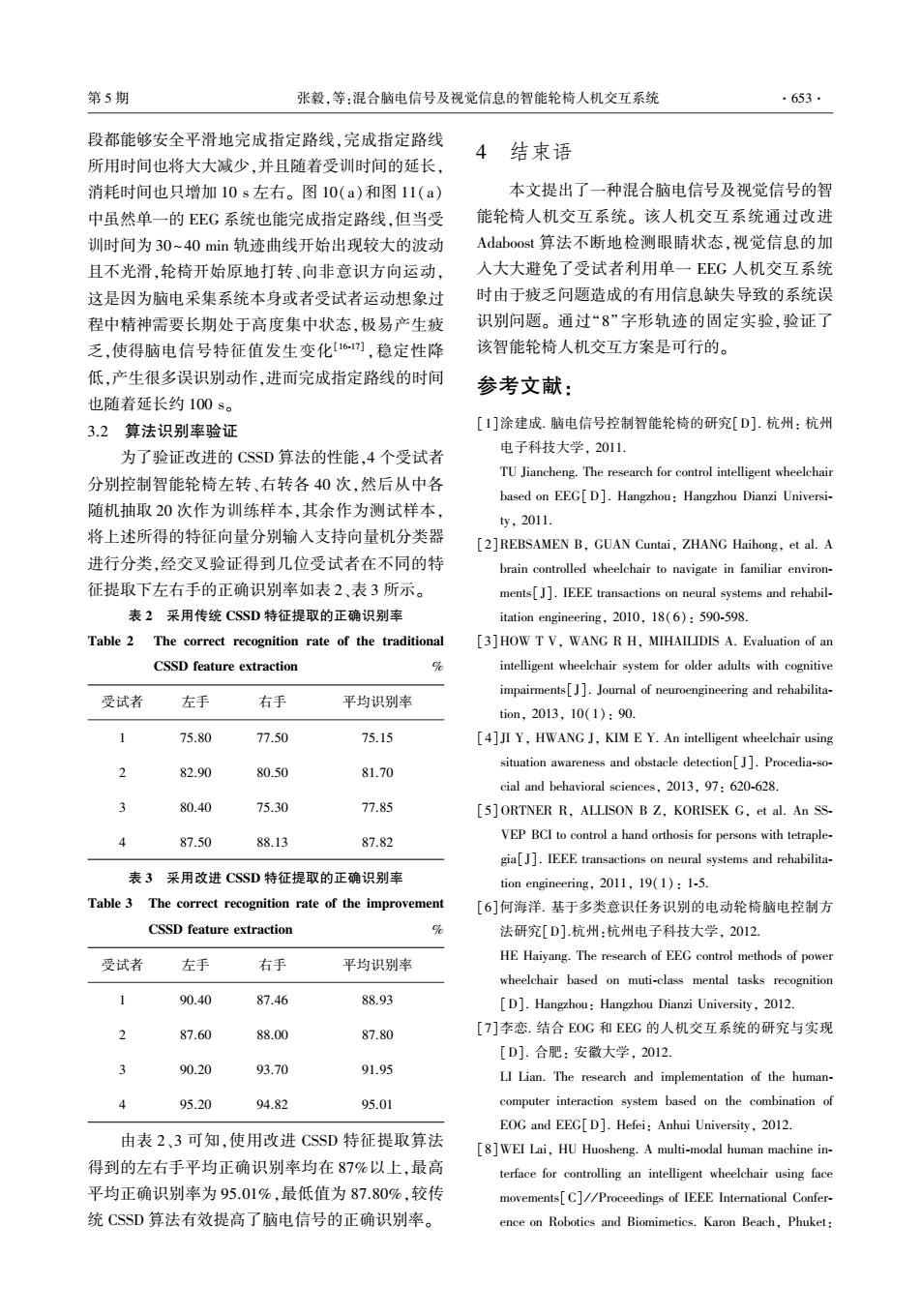正在加载图片...

第5期 张毅,等:混合脑电信号及视觉信息的智能轮椅人机交互系统 .653. 段都能够安全平滑地完成指定路线,完成指定路线 4结束语 所用时间也将大大减少,并且随着受训时间的延长, 消耗时间也只增加10s左右。图10(a)和图11(a) 本文提出了一种混合脑电信号及视觉信号的智 中虽然单一的EEG系统也能完成指定路线,但当受 能轮椅人机交互系统。该人机交互系统通过改进 训时间为30~40min轨迹曲线开始出现较大的波动 Adaboost算法不断地检测眼睛状态,视觉信息的加 且不光滑,轮椅开始原地打转、向非意识方向运动, 入大大避免了受试者利用单一EEG人机交互系统 这是因为脑电采集系统本身或者受试者运动想象过 时由于疲乏问题造成的有用信息缺失导致的系统误 程中精神需要长期处于高度集中状态,极易产生疲 识别问题。通过“8”字形轨迹的固定实验,验证了 乏,使得脑电信号特征值发生变化6],稳定性降 该智能轮椅人机交互方案是可行的。 低,产生很多误识别动作,进而完成指定路线的时间 参考文献: 也随着延长约100s。 3.2算法识别率验证 [1]涂建成.脑电信号控制智能轮椅的研究[D].杭州:杭州 为了验证改进的CSSD算法的性能,4个受试者 电子科技大学,2011. TU Jiancheng.The research for control intelligent wheelchair 分别控制智能轮椅左转、右转各40次,然后从中各 based on EEG[D].Hangzhou:Hangzhou Dianzi Universi- 随机抽取20次作为训练样本,其余作为测试样本, y,2011」 将上述所得的特征向量分别输入支持向量机分类器 [2]REBSAMEN B,GUAN Cuntai,ZHANG Haihong,et al.A 进行分类,经交叉验证得到几位受试者在不同的特 brain controlled wheelchair to navigate in familiar environ- 征提取下左右手的正确识别率如表2、表3所示。 ments[J].IEEE transactions on neural systems and rehabil- 表2采用传统CSSD特征提取的正确识别率 itation engineering,2010,18(6):590-598 Table 2 The correct recognition rate of the traditional [3]HOW T V,WANG R H,MIHAILIDIS A.Evaluation of an CSSD feature extraction % intelligent wheelchair system for older adults with cognitive impairments[].Journal of neuroengineering and rehabilita- 受试者 左手 右手 平均识别率 tion,2013,10(1):90. 75.80 77.50 75.15 [4]JI Y,HWANG J,KIM E Y.An intelligent wheelchair using situation awareness and obstacle detection].Procedia-so- 2 82.90 80.50 81.70 cial and behavioral sciences,2013,97:620-628. 80.40 75.30 77.85 [5]ORTNER R,ALLISON B Z,KORISEK G,et al.An SS. 87.50 88.13 87.82 VEP BCI to control a hand orthosis for persons with tetraple- gia[].IEEE transactions on neural systems and rehabilita- 表3采用改进CSSD特征提取的正确识别率 tion engineering,2011,19(1):1-5. Table 3 The correct recognition rate of the improvement [6]何海洋.基于多类意识任务识别的电动轮椅脑电控制方 CSSD feature extraction % 法研究[D].杭州:杭州电子科技大学,2012. 受试者 左手 右手 平均识别率 HE Haiyang.The research of EEG control methods of power wheelchair based on muti-class mental tasks recognition 90.40 87.46 88.93 [D].Hangzhou:Hangzhou Dianzi University,2012. 2 87.60 88.00 87.80 [7]李恋.结合E0G和EEG的人机交互系统的研究与实现 [D].合肥:安徽大学,2012. 90.20 93.70 91.95 LI Lian.The research and implementation of the human- 95.20 94.82 95.01 computer interaction system based on the combination of EOG and EEG[D].Hefei:Anhui University,2012 由表2、3可知,使用改进CSSD特征提取算法 [8]WEI Lai,HU Huosheng.A multi-modal human machine in- 得到的左右手平均正确识别率均在87%以上,最高 terface for controlling an intelligent wheelchair using face 平均正确识别率为95.01%,最低值为87.80%,较传 movements[C]//Proceedings of IEEE International Confer- 统CSSD算法有效提高了脑电信号的正确识别率。 ence on Robotics and Biomimetics.Karon Beach,Phuket:段都能够安全平滑地完成指定路线,完成指定路线 所用时间也将大大减少,并且随着受训时间的延长, 消耗时间也只增加 10 s 左右。 图 10(a)和图 11(a) 中虽然单一的 EEG 系统也能完成指定路线,但当受 训时间为 30~40 min 轨迹曲线开始出现较大的波动 且不光滑,轮椅开始原地打转、向非意识方向运动, 这是因为脑电采集系统本身或者受试者运动想象过 程中精神需要长期处于高度集中状态,极易产生疲 乏,使得脑电信号特征值发生变化[16⁃17] ,稳定性降 低,产生很多误识别动作,进而完成指定路线的时间 也随着延长约 100 s。 3.2 算法识别率验证 为了验证改进的 CSSD 算法的性能,4 个受试者 分别控制智能轮椅左转、右转各 40 次,然后从中各 随机抽取 20 次作为训练样本,其余作为测试样本, 将上述所得的特征向量分别输入支持向量机分类器 进行分类,经交叉验证得到几位受试者在不同的特 征提取下左右手的正确识别率如表 2、表 3 所示。 表 2 采用传统 CSSD 特征提取的正确识别率 Table 2 The correct recognition rate of the traditional CSSD feature extraction % 受试者 左手 右手 平均识别率 1 75.80 77.50 75.15 2 82.90 80.50 81.70 3 80.40 75.30 77.85 4 87.50 88.13 87.82 表 3 采用改进 CSSD 特征提取的正确识别率 Table 3 The correct recognition rate of the improvement CSSD feature extraction % 受试者 左手 右手 平均识别率 1 90.40 87.46 88.93 2 87.60 88.00 87.80 3 90.20 93.70 91.95 4 95.20 94.82 95.01 由表 2、3 可知,使用改进 CSSD 特征提取算法 得到的左右手平均正确识别率均在 87%以上,最高 平均正确识别率为 95.01%,最低值为 87.80%,较传 统 CSSD 算法有效提高了脑电信号的正确识别率。 4 结束语 本文提出了一种混合脑电信号及视觉信号的智 能轮椅人机交互系统。 该人机交互系统通过改进 Adaboost 算法不断地检测眼睛状态,视觉信息的加 入大大避免了受试者利用单一 EEG 人机交互系统 时由于疲乏问题造成的有用信息缺失导致的系统误 识别问题。 通过“8”字形轨迹的固定实验,验证了 该智能轮椅人机交互方案是可行的。 参考文献: [1]涂建成. 脑电信号控制智能轮椅的研究[D]. 杭州: 杭州 电子科技大学, 2011. TU Jiancheng. The research for control intelligent wheelchair based on EEG[D]. Hangzhou: Hangzhou Dianzi Universi⁃ ty, 2011. [2]REBSAMEN B, GUAN Cuntai, ZHANG Haihong, et al. A brain controlled wheelchair to navigate in familiar environ⁃ ments[J]. IEEE transactions on neural systems and rehabil⁃ itation engineering, 2010, 18(6): 590⁃598. [3]HOW T V, WANG R H, MIHAILIDIS A. Evaluation of an intelligent wheelchair system for older adults with cognitive impairments[J]. Journal of neuroengineering and rehabilita⁃ tion, 2013, 10(1): 90. [4]JI Y, HWANG J, KIM E Y. An intelligent wheelchair using situation awareness and obstacle detection[J]. Procedia⁃so⁃ cial and behavioral sciences, 2013, 97: 620⁃628. [5]ORTNER R, ALLISON B Z, KORISEK G, et al. An SS⁃ VEP BCI to control a hand orthosis for persons with tetraple⁃ gia[J]. IEEE transactions on neural systems and rehabilita⁃ tion engineering, 2011, 19(1): 1⁃5. [6]何海洋. 基于多类意识任务识别的电动轮椅脑电控制方 法研究[D].杭州:杭州电子科技大学, 2012. HE Haiyang. The research of EEG control methods of power wheelchair based on muti⁃class mental tasks recognition [D]. Hangzhou: Hangzhou Dianzi University, 2012. [7]李恋. 结合 EOG 和 EEG 的人机交互系统的研究与实现 [D]. 合肥: 安徽大学, 2012. LI Lian. The research and implementation of the human⁃ computer interaction system based on the combination of EOG and EEG[D]. Hefei: Anhui University, 2012. [8]WEI Lai, HU Huosheng. A multi⁃modal human machine in⁃ terface for controlling an intelligent wheelchair using face movements[C] / / Proceedings of IEEE International Confer⁃ ence on Robotics and Biomimetics. Karon Beach, Phuket: 第 5 期 张毅,等:混合脑电信号及视觉信息的智能轮椅人机交互系统 ·653·